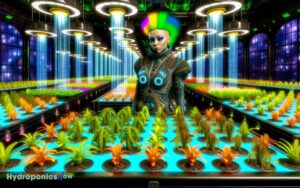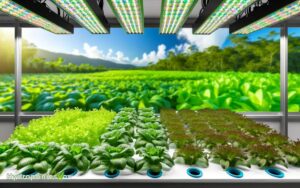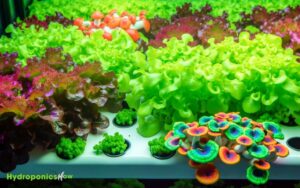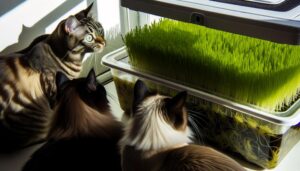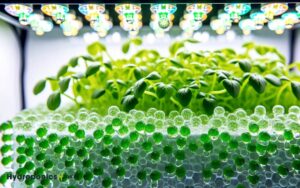How Much Water Do Hydroponic Plants Need Oxygen Not Included
In Oxygen Not Included, hydroponic plants need precise water management for peak growth. Consistently maintain water levels so roots are adequately submerged without drowning.
Monitor pH (5.5-6.5) and EC levels tailored to each plant type. Keep the temperature stable and oxygenate water to prevent root rot. Lettuce and spinach require high water, while tomatoes and strawberries need more during flowering.
Use digital sensors for accurate water level monitoring and guarantee proper drainage. By fine-tuning these factors, you’ll achieve healthy, high-yielding plants.
Understanding specific water needs per plant type enhances growth and productivity. Explore advanced tips to maximize your hydroponic setup.

Key Takeaways
Understanding Hydroponics in ONI
Hydroponics in ONI, or Oxygen Not Included, involves cultivating plants without soil, using nutrient-rich water solutions to optimize growth and resource management.
You’ll need to set up hydroponic farms, which require careful planning and precise execution. Each plant species has specific requirements for temperature, light, and nutrients. It’s important to monitor these variables closely to maximize efficiency and yield.
You’ll use hydroponic farm tiles that connect to liquid pipes, delivering the nutrient solution directly to the plant roots. Make sure your water supply is consistent and contains the necessary nutrients.
Importance of Water Management
Effective water management is essential in hydroponics to guarantee plants receive the right amount of nutrients without wasting resources. You must consistently monitor water levels and quality to ensure ideal plant growth.
Water serves as the medium for nutrient delivery, so maintaining the correct pH and electrical conductivity (EC) is vital. Overwatering can lead to root rot, while underwatering can stress plants, impairing their growth.
Efficient water usage minimizes costs and environmental impact. Implementing a closed-loop system helps recycle water, further enhancing efficiency.
By using sensors and automated systems, you can precisely control water distribution, ensuring plants thrive without resource depletion.
Mastering water management techniques is key to successful hydroponic cultivation.
Basic Water Requirements
Understanding the fundamental water requirements for hydroponic plants is essential to guaranteeing their peak growth and health. You’ll need to maintain ideal water levels, which means consistently monitoring and adjusting to meet the plants’ needs.
Hydroponic systems rely on water as the primary medium for nutrient delivery, so it’s vital to keep the water pH between 5.5 and 6.5 for peak nutrient uptake.
Regularly check the electrical conductivity (EC) to ensure nutrient concentration is within the ideal range, typically 1.2 to 2.0 mS/cm.
Additionally, water temperature should be maintained between 65°F and 75°F to prevent root disease and promote healthy growth. Accurate water management leads to robust plants and maximizes yield potential.
Plant Types and Needs
Different hydroponic plants have specific water needs that depend on their species, growth stage, and environmental conditions. You’ll need to tailor your water delivery system for best growth.
Here’s a detailed look at water requirements for common hydroponic plants:
| Plant Type | Water Needs | Growth Stage |
|---|---|---|
| Lettuce | High | Early to Mature |
| Tomatoes | Moderate to High | Flowering |
| Basil | Moderate | All Stages |
| Spinach | High | Early to Mature |
| Strawberries | Moderate to High | Flowering |
Understanding these needs ensures you manage the water supply effectively. Lettuce and spinach thrive with high water levels, especially in early growth.
Tomatoes and strawberries need more water during flowering. Basil stays consistent. Tailoring water levels to each plant type maximizes efficiency and yield.
Setting Up Hydroponic Farms
To guarantee you meet the specific water needs of your hydroponic plants, it’s essential to set up your hydroponic farm with a well-designed and adaptable water delivery system.
Begin by selecting the right type of hydroponic system tailored to your plant’s needs. Make sure your setup includes efficient water circulation and aeration.
Follow these steps:
- Choose the Right System: Select between nutrient film technique (NFT), deep water culture (DWC), or drip systems based on your plants’ requirements.
- Water Quality Monitoring: Regularly check pH and nutrient levels to maintain excellent plant health.
- Efficient Aeration: Use air stones or diffusers to oxygenate the water, preventing root rot.
- Proper Drainage: Implement a drainage system to avoid waterlogging and ensure nutrient flow.
This meticulous setup ensures robust plant growth and resource efficiency.
Water Delivery Systems
When considering water delivery systems for hydroponic plants, you need to evaluate the efficiency of drip irrigation.
The benefits of the Nutrient Film Technique (NFT) are also important to consider. Additionally, you should assess the practicality of the flood and drain method.
Each system offers distinct advantages in water use, oxygenation, and nutrient delivery. Understanding these methods will help you optimize plant growth and resource management in your hydroponic setup.
Drip Irrigation Efficiency
Drip irrigation systems excel in hydroponic setups by precisely delivering water and nutrients directly to plant roots, thereby minimizing waste and maximizing growth efficiency.
These systems offer several advantages for ideal plant development:
- Water Conservation: By targeting the root zone, you reduce water evaporation and runoff, resulting in significant water savings.
- Nutrient Management: Nutrients are delivered in a controlled manner, ensuring plants receive the necessary elements without excess.
- Scalability: Drip systems can be easily scaled to accommodate different plant quantities and sizes, making them versatile.
- Disease Prevention: By keeping foliage dry, you minimize the risk of fungal diseases which thrive in moist environments.
Understanding these components will help you optimize your hydroponic drip irrigation system for maximum efficiency.
Nutrient Film Technique
The Nutrient Film Technique (NFT) stands as a cornerstone in hydroponic water delivery systems. A thin film of nutrient-rich water continuously circulates over the plant roots, ensuring peak absorption and growth.
In NFT, you’ll find an efficient use of water and nutrients, reducing waste and ensuring plants receive a constant supply. The key to NFT’s success lies in maintaining an ideal flow rate and ensuring the channel slope is correctly angled to avoid pooling.
This technique minimizes water stagnation, promoting oxygenation of the root zone. Regular monitoring of nutrient concentration and pH levels is essential, as imbalances can quickly affect plant health.
Flood and Drain
Flood and Drain systems, also known as Ebb and Flow, offer a highly effective method for hydroponic water delivery by periodically flooding the grow tray with nutrient solution before allowing it to drain back into a reservoir.
This system guarantees roots receive ample oxygen and nutrients, promoting robust plant growth.
Here’s how it works:
- Cycle Timing: Set precise intervals for flooding and draining to maintain peak root health. Typically, 3-4 cycles per day are ideal.
- Water Volume: Make sure the reservoir holds enough nutrient solution to fully submerge the root zone during flooding.
- Pump Efficiency: Use a reliable pump to ensure consistent water flow and prevent system failures.
- Drainage System: Implement an efficient drainage mechanism to avoid waterlogging and ensure rapid drainage.
Monitoring Water Levels
You’ll need to maintain ideal water levels to guarantee your hydroponic plants thrive. Use precise measuring techniques, such as electronic sensors or manual gauges, to monitor these levels accurately.
Adjust your water supply promptly based on these readings to prevent nutrient imbalances and root damage.
Ideal Water Levels
Accurately monitoring water levels in your hydroponic system is crucial for maintaining peak plant health and maximizing growth efficiency.
You need to guarantee that water levels are neither too high nor too low, as both extremes can jeopardize plant health. Ideal water levels support peak nutrient uptake and oxygenation, preventing root rot and nutrient deficiencies.
Here’s what to keep in mind:
- Maintain Consistency: Fluctuating water levels stress plants, hindering growth.
- Monitor Root Submersion: Ensure roots are adequately submerged without drowning.
- Check for Evaporation: Regularly top up the system to compensate for water loss.
- Balance Nutrient Solution: Consistent water levels aid in maintaining the correct nutrient concentration.
Measuring Techniques
To accurately monitor water levels in your hydroponic system, employing reliable measuring techniques is crucial.
Start with digital water level sensors for precise readings, allowing real-time monitoring. These sensors can be integrated with automated systems for alerts, guaranteeing timely interventions.
Use manual methods like sight tubes or dipsticks as supplementary checks. Calibrate your sensors regularly to maintain precision. Employ redundancy by using multiple sensors in key locations within your system to cross-verify data.
Keep detailed logs of water levels, noting any deviations to understand trends and potential issues. Consistently monitoring guarantees favorable conditions for plant growth, prevents root rot, and maintains nutrient balance.
Mastering these techniques will enhance your hydroponic system’s efficiency and productivity.
Adjusting Water Supply
Consistently adjusting the water supply in your hydroponic system is important to maintaining peak plant health and growth. Monitoring water levels guarantees your plants receive the right amount of nutrients and oxygen.
Here’s how you can fine-tune your system:
- Daily Checks: Measure water levels daily to prevent fluctuations that can stress plants.
- Automated Sensors: Install water level sensors to automate monitoring and maintain consistency.
- Nutrient Solution: Regularly test and adjust nutrient concentrations as water levels change.
- Reservoir Management: Make sure your reservoir has sufficient capacity to accommodate water usage and evaporation.
Balancing Water and Nutrients
Maintaining the perfect balance between water and nutrients is crucial for optimizing the growth and health of hydroponic plants. You need to monitor the Electrical Conductivity (EC) and pH levels of your nutrient solution.
Aim for an EC range tailored to your specific plants; for example, leafy greens often thrive with an EC of 1.2-2.0 mS/cm. Keep your pH level between 5.5 and 6.5 to guarantee nutrient availability.
Regularly check these metrics using reliable meters. Don’t forget to adjust the nutrient concentration based on plant growth stages seedlings require less than mature plants.
Additionally, make sure nutrient solutions are oxygenated to prevent root diseases. By maintaining this balance, you’ll promote vigorous growth and higher yields in your hydroponic system.
Common Watering Mistakes
You might think more water is better, but overwatering hydroponic systems can suffocate plant roots and lead to nutrient imbalances.
It’s also critical to tailor water schedules to each plant’s unique needs, as ignoring these can stunt growth or cause deficiencies.
Proper monitoring and adjustments are essential for peak plant health.
Overwatering Hydroponic Systems
One of the most critical mistakes in hydroponic gardening is overwatering, which can lead to root rot and nutrient imbalances. To avoid this, you need to understand the best hydration levels for your plants.
Here’s how you can prevent overwatering:
- Monitor Root Health: Regularly inspect roots for signs of rot, such as browning or a mushy texture.
- Adjust Watering Schedule: Tailor your watering intervals to the specific needs of your plant species.
- Maintain Proper Drainage: Make sure your hydroponic system has adequate drainage to prevent waterlogging.
- Check Oxygen Levels: Sustain proper oxygenation in the root zone with air stones or pumps to support healthy root development.
Ignoring Plant Water Needs
After addressing the risks of overwatering, it’s equally important to avoid common mistakes that arise from ignoring your plants’ specific water needs.
Each type of plant has unique requirements some thrive in high-moisture environments, while others prefer drier conditions. Neglecting these needs can lead to nutrient deficiencies, stunted growth, or root diseases.
You must regularly monitor moisture levels, adjust your hydroponic system’s settings, and consider the plant’s growth stage. Utilize moisture sensors and pH meters to guarantee ideal hydration and nutrient uptake.
Advanced Water Management Tips
Mastering advanced water management in hydroponics involves precise monitoring and adjustment of pH levels, nutrient concentrations, and water temperature to optimize plant growth. You’ve got to understand the intricacies of each parameter to guarantee that your plants thrive.
- pH Levels: Keep pH between 5.5 and 6.5 to guarantee nutrient availability. Use a digital pH meter for accuracy.
- Nutrient Concentrations: Regularly check and adjust nutrient solutions to avoid deficiencies or toxicities. EC meters can help maintain ideal levels.
- Water Temperature: Maintain water temperature between 65-75°F (18-24°C) to enhance nutrient uptake and prevent root diseases.
- Oxygenation: Ensure proper aeration using air stones or pumps to keep dissolved oxygen levels high, promoting root health and vigorous growth.
Implement these tips to master water management.
Maximizing Crop Yield
Building on effective water management, you can maximize crop yield by fine-tuning light intensity, optimizing nutrient schedules, and ensuring proper plant spacing.
- Start by adjusting the light intensity to match the specific requirements of each plant species. Use PAR meters to measure and adjust light levels precisely.
- Next, tailor nutrient schedules to the growth stages of your crops. Implement a nutrient solution that balances macro and micronutrients, ensuring they’re readily available.
- Finally, proper plant spacing prevents overcrowding, promoting airflow and reducing disease risk. Use grid systems to maintain consistent spacing.
Conclusion
Mastering hydroponics in Oxygen Not Included demands impeccable water management. By understanding each plant’s specific needs and balancing water with nutrients, you’ll prevent common mistakes and maximize crop yield. Efficient irrigation systems and automated plumbing can further streamline the process, ensuring plants receive the exact amount of water they need. Additionally, monitoring colony air quality is crucial; learning how to measure oxygen output helps maintain a balanced atmosphere for both crops and duplicants. By fine-tuning these systems, you can create a self-sustaining food supply while conserving vital resources.
Remember, even a single droplet can make or break your farm’s success.
Dive deep into advanced techniques to guarantee your hydroponic setup thrives. Commit to these practices, and you’ll cultivate plants so vibrant, they’ll practically leap out of their beds with vitality.

